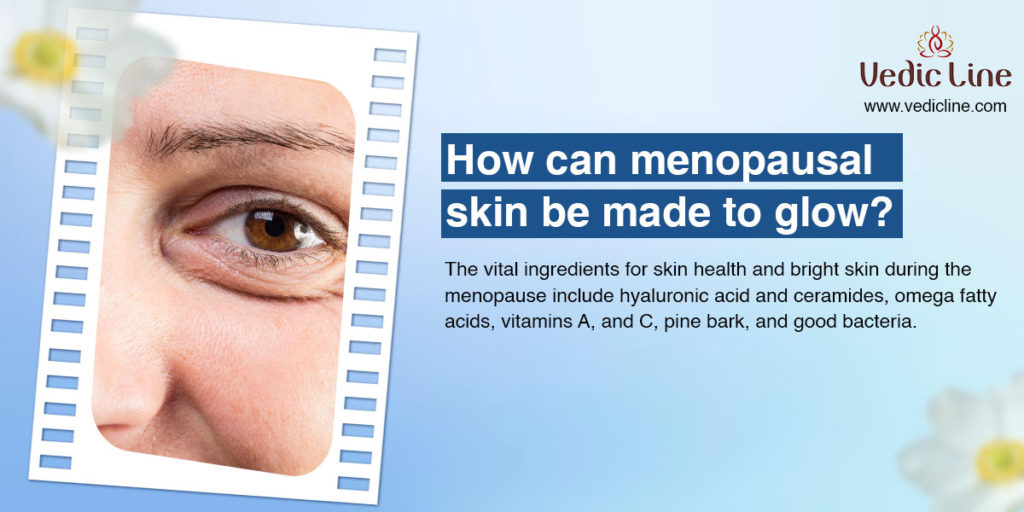In-Depth 9-Step Skincare Routine for Menopausal Skin

A normal stage of life called menopause causes considerable hormonal changes. As estrogen levels decline, your skin’s needs change too. To help you navigate this transition and keep your skin healthy and radiant, we’ve put together a tailored & designed specifically skincare routine for menopausal skin. Embrace these simple steps to nourish and care for your skin during this transformative period. Before we start let’s discuss what exactly menopause is.
What is Menopause?
Menopause, a normal biological process, marks the end of a woman’s fertile years. The exact timeframe varies from person to person, although it usually happens between the ages of 45 and 55. During menopause, a woman’s ovaries gradually decrease their production of reproductive hormones like estrogen and progesterone.
The process of menopause is often defined by the absence of menstruation (periods) for 12 consecutive months. It’s a normal part of the aging process and signifies the transition from the reproductive phase of a woman’s life to the post-reproductive phase. Menopause is a complex hormonal shift that can bring about various physical and emotional changes in a woman’s body.

Symptoms Of Menopause
Irregular Periods: Menstrual cycles may become irregular in terms of timing, flow, and duration as hormone levels fluctuate.
Hot Flashes and Night Sweats: Sudden and intense feelings of heat, often accompanied by sweating and flushed skin, especially during the night.
Mood Swings: Hormonal changes can lead to mood swings, irritability, and even feelings of depression or anxiety.
Vaginal Dryness: Reduced estrogen levels can cause vaginal tissues to become thinner and drier, leading to discomfort during intercourse.
Sleep Disturbances: Night sweats and other symptoms can interfere with sleep patterns.
Changes in Skin and Hair: Decreased estrogen levels can impact skin elasticity, leading to drier skin, and also influence hair texture and growth.
Bone Density Changes: Lower estrogen levels can contribute to a decrease in bone density, increasing the risk of osteoporosis.
While menopause is a natural process, its symptoms can be managed through various means, including lifestyle adjustments, hormone replacement therapy (HRT), and other medical treatments. Women need to consult with their healthcare provider to discuss their symptoms and determine the best course of action for managing the effects of menopause.

Skincare Routine for Menopausal Skin
Step 1: Gentle Cleansing
Start your routine with a gentle cleanser that effectively removes impurities without stripping your skin’s natural oils. Opt for a sulfate-free, creamy cleanser to avoid over-drying. Cleanse your face twice a day – once in the morning and once before bed – to maintain a clean canvas for the rest of your routine.
Step 2: Hydration is Key
Menopausal skin tends to be drier due to the reduction in estrogen levels. Maintaining hydration is essential for keeping skin soft. Use a hydrating toner with ingredients like hyaluronic acid to help your skin retain moisture. Apply the toner after cleansing to prepare your skin for subsequent products.
Step 3: Targeted Treatments:
Incorporate serums or treatments that address specific concerns. Look for products containing antioxidants like vitamin C to combat free radicals and support collagen production. Additionally, consider products with peptides to help firm and plump the skin. Apply these treatments after your toner and allow them to absorb fully.
Step 4: Moisturize Intensively:
Choose a rich, nourishing moisturizer to lock in hydration and create a protective barrier on your skin. Ingredients like ceramides, shea butter, and niacinamide can help fortify your skin’s moisture barrier and soothe any irritation. Apply your moisturizer morning and night, adjusting the amount depending on your skin’s needs.
Step 5: Sun Protection:
Never underestimate the importance of sun protection, even during menopause. Use a broad-spectrum SPF 30 or higher sunscreen daily to shield your skin from harmful UV rays. Sun protection is key to preventing premature aging and maintaining an even skin tone.
Step 6: Nighttime Renewal:
At night, prioritize products that aid in skin repair and rejuvenation. Consider using a retinol product to stimulate collagen production, improve texture, and address fine lines. Begin by applying retinol a few times a week and gradually increase frequency as your skin tolerates it.
Step 7: Eye Care:
Our eyes have delicate skin around the and deserve special attention. Choose an eye cream with hydrating ingredients like hyaluronic acid and peptides to reduce puffiness and minimize the appearance of fine lines and wrinkles.
Step 8: Weekly Treatments:
Incorporate a weekly exfoliation or mask treatment to gently slough off dead skin cells and promote cell turnover. Look for exfoliants with mild acids like glycolic or lactic acid, or use a hydrating mask to replenish moisture.
Step 9: Inner Wellness:
Remember that skincare isn’t only about external products; it’s also about nourishing your body from within. Stay hydrated, eat a balanced diet rich in antioxidants, and consider consulting a healthcare professional about supplements that may benefit your skin.

Conclusion:
Menopause is a transformative phase that calls for adjustments in your skincare routine for menopausal skin. By following these steps and tailoring them to your specific needs, you can support your skin’s health and radiance during this time of change. Embrace the journey and give your skin the care it deserves.
